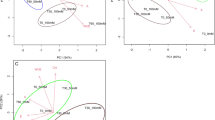Abstract
Eastern white pine (P. strobus) seedlings were subjected to controlled nightly mists acidified with nitric and sulfuric acids at pH levels of 5.6, 4.6, 3.6 and 2.6 in environmental chambers. After a 6-week exposure, needles which developed during that time were examined by light microscopy and scanning electron microscopy for morphological aberrations, and for changes in total and partial transverse dimensions. Calculation and estimation of these transverse dimensions were accomplished through a point counting technique, and by simple linear measurement of abaxial needle widths, respectively. No gross surface or internal structural alterations were observed; however, subtle yet statistically significant increases in areas and abaxial widths were detected in needle transections with increased acidity of treatment. This trend was attributed to nutritional effects of the nitrogen and sulfur components of the HNO3 and H2SO4 in the acid mists.
Similar content being viewed by others
References
Abelson PH (1983) Acid rain. Science 221:115
Abrahamsen, G (1980) Acid precipitation, plant nutrients and forest growth. In: DrablØs D, Tollan A (eds) Ecological impact of acid precipitation. SNSF project, Oslo-As, Norway, pp 58–63
Blanpied GD (1979) Effect of artificial rain water, pH, and calcium concentration on the calcium and potassium in apple leaves. HortScience 14:706–708
Cole DW, Johnson DW (1977) Atmospheric sulfate additions and cation leaching in a Douglas fir ecosystem. Water Resour Res 13:313–317
Cowling EB, Linthurst RA (1981) The acid precipitation phenomenon and its ecological consequences. BioScience 31:649–654
Crang RE, Robinson SG, Noble RD, Dochinger LS (1983) Acid fog effects on yellow poplar leaf morphology. Micron 14:75–76
Evans LS (1982) Biological effects of acidity in precipitation on vegetation: a review. Environ Exp Bot 22:155–169
Evans LS, Curry TM (1979) Differential responses of plant foliage to simulated acid rain. Am J Bot 66:953–962
Gordon CC (1972) Mount Storm study. US EPA Contract No 68-02-0229
Hindawi IJ, Ratsch HC (1974) Growth abnormalities of Christmas trees attributed to sulfur dioxide and particulate acid aerosol. Proc Annu Meet-Air Pollut Control Assoc #74–252
Hindawi U, Rea JA, Griffis WL (1980) Response of bush bean exposed to acid mist. Am J. Bot 67:168–172
Huffman WA Jr., Lindberg SE, Turner RR (1980) Precipitation acidity: the role of the forest canopy in acid exchange. J Environ Qual 9:95–100
Klein RM (1984) Ecosystems approach to the acid rain problem. In: Linthurst RA (ed) Direct and indirect effects of acidic deposition on vegetation. Butterworth Publishers, Stoneham, Massachusetts, pp 1–11
Lee JJ, Weber DE (1979) The effect of simulated acid rain on seedling emergence and growth of eleven woody species. For Sci 25:393–398
Likens GE, Wright RF, Galloway JN, Butler TJ (1979) Acid rain. Sci Am 241:43–51
NADP (1978 and 1979) National atmospheric deposition program data reports, vol II (1–3). Natural Resource Ecology Laboratory, CSU, Fort Collins, Colorado
Ogner G (1980) The effect of growth of Norway spruce on soil acidity by acid irrigation. In: DrablØs D, Tollan A (eds) Ecological impact of acid precipitation. SNSF project, Oslo-As, Norway, pp 208–209
Paparozzi ET, Tukey Jr. HB (1981) The effects of simulated acid rain on leaves ofPhaseolus vulgaris C.V. red kidney. HortScience 16:49
Popovich L (1983) Acid rain and forests: the pot begins to boil. Am For 89:42–44 50–53
Raynal DJ, Roman JR, Eichenlaub WM (1982) Response of tree seedlings to acid precipitation: II. Effect of simulated acidified canopy throughfall on sugar maple seedling growth. Environ Exp Bot 22:385–392
Scherbatskoy T, Klein RM (1983) Response of spruce and birch foliage to leaching by acidic mists. J Environ Qual 12:189–195
Shriner DS (1982) Air pollution impacts on forest trees: acid deposition: effects on terrestrial ecosystems. Proc Sov Am Symp, Tallin, USSR, p 132–134
Siccama TG, Bliss M, Vogelmann HW (1982) Decline of red spruce in the Green Mountains of Vermont. Bull Torrey Bot Club 109:162–168
Sokal RR, Rohlf FJ (1981) Biometry: the principles and practice of statistics in biological research. Second edition. WH Freeman and Co, San Francisco, California
Tamm CO, Cowling EB (1977) Acidic precipitation and forest vegetation. Water Air Soil Pollut 7:503–511
Vogelmann HW (1982) Catastrophe on Camels Hump. Nat His 91:8–14
Weibel ER (1979) Stereological methods: volume 1: Practical methods for biological morphometry. Academic Press, Orlando, Florida
Wood FA, Pennypacker SP (1976) Etiological study of the short needle disease of pine. US Forest Service Gen Tech Rep NE-23
Wood T, Bormann FH (1974) The effects of an artificial acid mist upon the growth ofBetula alleghaniensis Britt. Environ Pollut 7:259–268
Wood T, Bormann FH (1977) Short-term effects of a simulated acid rain upon the growth and nutrient relations ofPinus strobus, L. Water Air Soil Pollut 7:479–488
Author information
Authors and Affiliations
Rights and permissions
About this article
Cite this article
Maurice, C.G., Crang, R.E. Increase inPinus strobus needle transectional areas in response to acid misting. Arch. Environ. Contam. Toxicol. 15, 77–82 (1986). https://doi.org/10.1007/BF01055251
Received:
Revised:
Issue Date:
DOI: https://doi.org/10.1007/BF01055251




